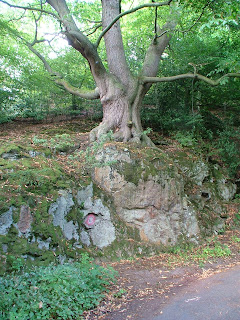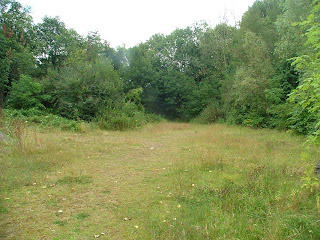Imperial maps of west Albion tend to be labelled ‘marsh’, ‘bog’, ‘fen’. So few explorers land upon these forsaken shores, and fewer still remain having done so, that any detailed cartography of the area is unavailable and uncalled for. The inhabitants of these regions have little use for maps and instruments too rudimentary to attempt any but the most basic cartographical survey. From travels and conversations with local tribes we have attempted to piece together a rough outline of the territorial regions and key geographical features. Circles on the map represent human settlements, standing stones indicate places of interest and dolmen denote rumoured Fimir settlements. No one was willing to vouch for the exact location of any Fimir site and we deemed our expedition team too small and ill-equipped to try and discover a Fimm city for ourselves.
Note: For ease of reading, this chart is oriented east (top) to west (bottom).
The coastline of south west Albion seems to be divided into two regions, Pernwold and Cairnwold. Wold, as far as I have been able to discern, simply means ‘region’. There are numerous ports (porthi) scattered along the coast and these seem to be relatively busy with trade to the northern parts of the Old World. Principle among the ports is that of Porthsmyth, situated at the mouth of the Ayefen river.
Further inland the landscape becomes bleaker, given over principally to moorland and marsh. This expanse is divided into three and it would appear that each region is the territory of a particular Fimir tribe. Human inhabitants rarely venture eastwards, and if they are forced to do so they skirt south through Bairnmot or north through the Boerdarlende. The largest of the moors is Darthemor (Mor means ‘clan’ in the Albion tongue, while ‘Darthe’ denotes the colour ochre. Possibly the Fimir of this region are ochre-hued, possibly the name originates from the bracken which colours the landscape a sandy brown). Darthemor contains several hill groups, from two of which spring the rivers Framm and Ayefen. These meet at a large body of water known as Drakkenmere. The hills are rumoured to be full of caves and the hillsides covered in standing stones of mysterious and unknown significance. Special mention should be made of the site known as Maelfean, ‘Hill of the source’. A few years back, we are told, a small craft aiming for Porthsmyth became hopelessly lost in thick mist and ended up in the Drakkenmere. Here their boat hit a submerged rock and sank. Travelling still in the wrong direction they worked their way eastwards up the Ayefern until it narrowed to a tiny stream. Nestled in the hills they observed from a distance the settlement of Maelfean. They describe a fortress of black stone and set upon the top of the highest crest. A great stone wall ringed the top of the hill, with a gate in the centre from which a track wound down the hill, following the course of the stream. There were cave mouths in the sides of the hills and to the east was what appeared to be a quarry site, presumably the source of the rock for the fort. At the base of the hill and around the quarry site were roundhouses and longhouses such as human clans might build and the travellers were tempted to approach and seek shelter for the night at the settlement. However, as they drew closer, and the night drew in, they could see the figures emerging from the huts. They describe the creatures they saw as ‘taller than a man, with barbed tails and a single eye’. The travellers managed to camp for the night undiscovered and made their way back along the Ayefen the following day, hewing a tree from woods around Drakkenmere and making an impromptu raft to carry them downstream, out of Darthemor. This is a significant discovery regarding the Fimir. Not only do we have one site where eyewitnesses attest to the existence of a Fimir stronghold, but we also see a unique occurrence in the existence of huts. Previously it has been thought that the Fimir live entirely within rock structures which front cave networks, but this has been based on examination of supposed habitations which have been deserted. It would seem the Fimir have either observed and made use of human design for their huts or that both humans and Fimir in this region were originally in closer communication.

The other two regions of marshland are Exenmor and Bodemeargh, both fed by the river Exe. Beyond these marshes lie Al Pernwaith and Rengolt, both sparsely inhabited by human tribes, principally the Damnonii at Al Dernholt and the Balgae in Verwutt. Of all the tribes we encountered, the Atrebodil were undoubtedly the strangest and most disturbing, as mentioned elsewhere, and I feel it is worth mentioning that their settlements are entirely within the region of Bairnmot, focussed around the settlement of Carmille and close to the standing stones at Bithkau. A fact, I feel, which is not unrelated to their bizarre behaviour. I venture this information so that any travellers to Albion may give these people a wide berth.

The geography, regions and peoples of south west Albion (by Francis Kiri)


















































